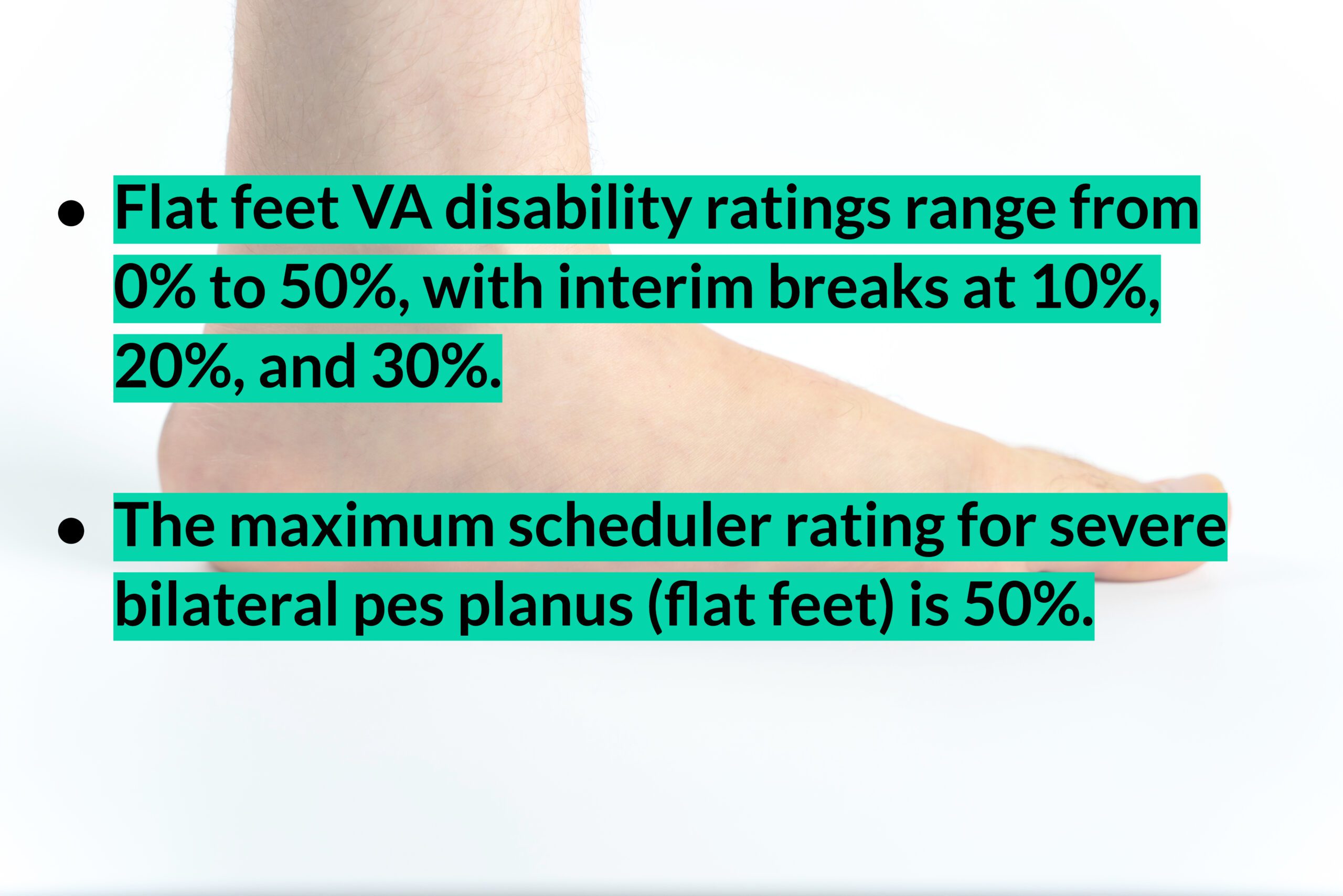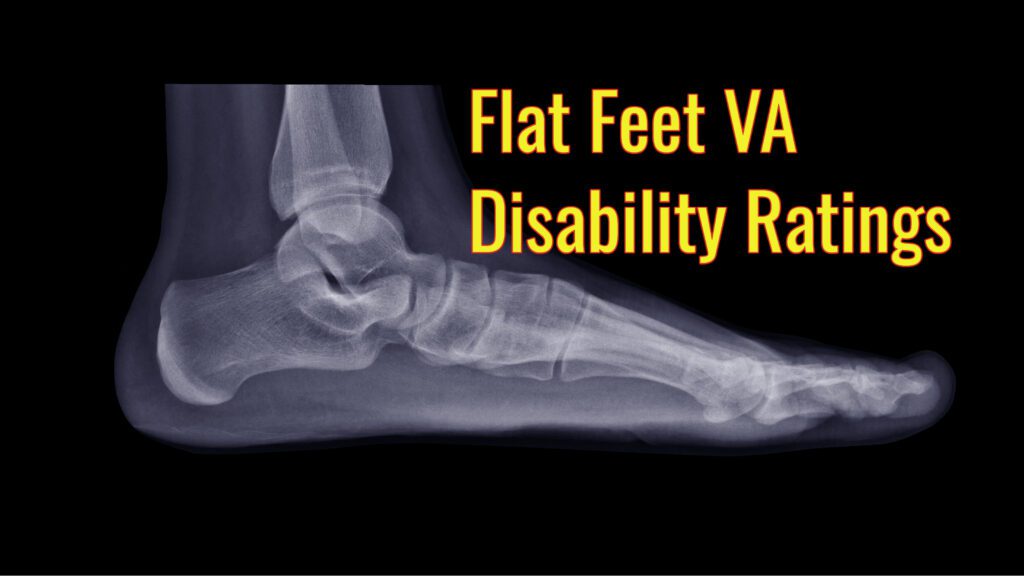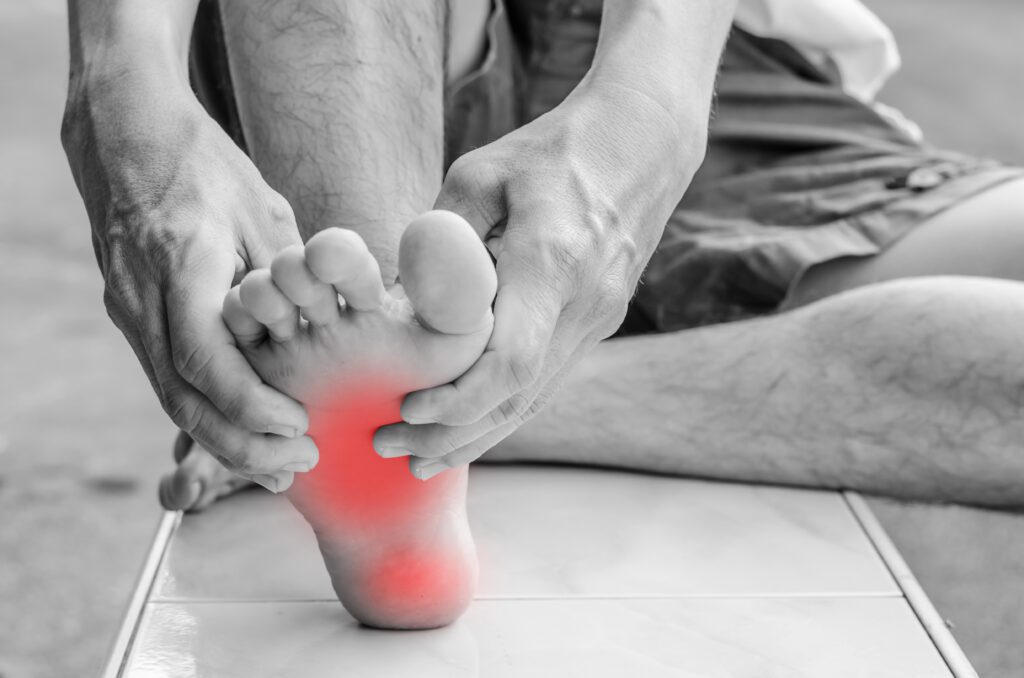Looking for Expert-Level VA Claim Answers?📱Call Us Now! 737-295-2226
Flat feet (pes planus) is more than just sore arches—it can lead to chronic pain, mobility issues, and even secondary conditions in your knees, hips, or back. And yet, many veterans don’t realize they qualify for a VA rating.
In this guide, I’ll break down the three best ways to get a VA rating for flat feet, explain the official rating criteria, and share expert-level tips to help you strengthen your claim—even if you’ve already been denied.
Table of Contents
Summary of Key Points
- Flat feet (pes planus) can qualify for VA disability compensation with ratings from 0% to 50%, depending on severity, functional loss, and whether one or both feet are affected.
- Veterans can earn service connection for flat feet three ways: directly, secondarily (to another service-connected condition), or via aggravation of a pre-existing disability.
- The VA uses Diagnostic Code 5276 to evaluate flat feet, considering factors like deformity, pain, callosities, and response to orthopedic treatment.
- Secondary conditions to flat feet—such as ankle, knee, hip, or back pain—can increase a veteran’s total combined disability rating.

What are Flat Feet (Pes Planus) in Veterans?
Veterans have flat feet when they have little to no arch (flattened foot), which lets the entire sole of one or both feet touch the ground when standing or walking.
Flat feet are a common condition that’s usually painless; however, they can become painful over time due to overuse, obesity, running, military combat boots, or wearing poor insoles.
Keep in mind flat feet can also develop after an injury or from everyday wear-and-tear, such as military service. Also note that you might have entered military service with flat feet, which is known as a “pre-service disability.”
Many veterans have flat feet aggravated by military service (beyond their natural progression), in which case, you’re eligible for a VA rating for flat feet based upon “aggravation of a pre-service disability,” assuming you have medical evidence showing that your flat feet worsened over time.
Flat feet can also cause problems in your ankles, knees, hips, and back because the condition can change the alignment of your legs—these are all common secondary conditions for secondary service connection.
There are several risk factors for flat feet, including obesity, injuries to your foot or ankles, rheumatoid arthritis, aging, and diabetes.

How to Service Connect Your Flat Feet for VA Disability
To get your VA claim for flat feet approved, you need to prove 3 essential elements:
- #1. Medical diagnosis of flat feet. This can be in Service Treatment Records (STRs), VA medical records, OR any private records, but it needs to be in a medical record. It does help to have a “current” medical diagnosis of pes planus within the past 12 months, although it’s not required.
- #2. Your flat feet were caused or made worse by your ACTIVE-DUTY military service (“Nexus”) OR it’s proximately due to or aggravated by ANOTHER service-connected disability rated at 0% or higher for secondary service connection.
- #3. Current symptoms of flat feet, which we call “Severity of Symptoms.” How severe are your symptoms, and how are your flat feet negatively impacting your work, life, and social functioning? Also, think about “Functional Impairment” or “Economic Loss” due to the severity of your flat feet.
If you think you have a foot disorder such as pes planus (flat feet) but don’t have a medical diagnosis, pick up the phone and call the VA facility nearest you to make an appointment right away.
You’ll likely be referred from your Primary Care Doctor to a Podiatrist, who is a medical professional who specializes in the treatment of disorders of the foot, ankle, and related structures of the leg.
If you’re trying to increase your VA disability rating for flat feet, you need to prove to the VA that your symptoms are now worse and warrant the higher rating criteria by law.
The #1 best way to increase your VA rating for pes planus is to have objective medical evidence that shows how your symptoms have worsened over time.
How to Get a VA Rating for Flat Feet
There are three primary ways a veteran can get a flat feet VA rating:
- Direct Service Connection for Flat Feet rated either unilateral or bilateral, with VA ratings of 0%, 10%, 20%, 30%, or 50%.
- Secondary Service Connection for Flat Feet rated either unilateral or bilateral, with VA ratings of 0%, 10%, 20%, 30%, or 50%. For instance, a veteran could be rated for Flat Feet secondary to Ankle Pain.
- Aggravation of a Pre-Service Disability for Flat Feet rated either unilateral or bilateral, with VA ratings of 0%, 10%, 20%, 30%, or 50%. For example, a veteran could be rated for Flat Feet due to aggravation of a pre-service disability. This means you had the condition before you joined the military, but your military service aggravated your flat feet beyond their natural progression.

What are the Flat Feet VA Disability Ratings?
The VA rates flat feet using Title 38 CFR, Part 4, Schedule for Rating Disabilities, Diagnostic Code (DC) 5276, Flatfoot, Acquired.
Flat feet VA disability ratings range from 0% to 50%, with interim breaks at 10%, 20%, and 30% depending upon unilateral or bilateral and the severity of your symptoms in terms of frequency, severity, and duration.
50 Percent Flat Feet VA Rating (Bilateral)
The 50 percent VA rating is appropriate for severe bilateral flat feet pronounced with marked pronation, extreme tenderness of plantar surfaces of the feet, marked inward displacement, and severe spasm of the tendo achillis on manipulation, not improved by orthopedic shoes or appliances.
30 Percent VA Rating for Pes Planus (Unilateral)
The 30 percent VA rating is appropriate for severe unilateral flat feet pronounced with marked pronation, extreme tenderness of plantar surfaces of the feet, marked inward displacement, and severe spasm of the tendo achillis on manipulation, not improved by orthopedic shoes or appliances.
30 Percent VA Disability Rating for Flat Feet (Bilateral)
The 30 percent rating for pes planus is appropriate for bilateral flat feet with objective evidence of marked deformity (pronation, abduction, etc.), pain on manipulation and use accentuated, indication of swelling on use, characteristic callosities (yellow calluses). The photo below is an example of yellow calluses and cracking of the heel.
20 Percent VA Rating for Pes Planus (Unilateral)
The 20 percent rating for flat feet is appropriate for unilateral pes planus with objective evidence of marked deformity (pronation, abduction, etc.), pain on manipulation and use accentuated, indication of swelling on use, characteristic callosities (yellow calluses).
10 Percent Pes Planus VA Rating (Bilateral or Unilateral)
The 10 percent VA rating for pes planus is appropriate for moderate symptoms such as weight-bearing line over or medial to great toe, inward bowing of the tendo achillis, pain on manipulation and use of the feet, bilateral or unilateral.
0 Percent VA Rating for Flat Feet (Bilateral or Unilateral)
The 0 percent VA disability rating for flat feet is appropriate for mild symptoms relieved by built-up shoe or arch support.
Flat Feet Claim Denied?
Receiving a denied claim when you feel you are owed VA disability benefits is highly discouraging. However, if you have your flat feet claim denied—don’t give up. If you deserve VA disability for flat feet—you still have options, including:
- File a Supplemental Claim if you have new and relevant evidence that you didn’t have before your case was reviewed.
- Ask for a Higher-Level Reviewer to review your case. (New evidence can’t be submitted)
- Appeal to the Board of Veterans’ Appeals and have a Veterans Law Judge review your case.
You shouldn’t wait to file your appeal if you suffer from severe symptoms from pes planus flat feet. Remember, if you served, you deserve.

What is the Pain Motion Principle for Flat Feet?
The painful motion principle means that regardless of range of motion, if pain is present, the veteran should at least be awarded the minimum level of compensable disability for that condition.
For example, let’s say you have full range of motion for your flat feet and no functional impairment or loss, but you have pain during movement, then you should be awarded the minimum level of disability for pes planus, which is 10%.
List of VA Secondary Conditions to Flat Feet
In veterans with symptoms, there may be complaints of the midfoot, heels, lower legs, knees, hips, and or back pain, which can all be linked and rated as secondary conditions to flat feet.
Other conditions linked to flat feet in a bi-directional relationship include leg length differences, pregnancy, Marfan’s syndrome, rheumatoid arthritis, and scoliosis, obesity, injuries to your foot or ankles, and diabetes.
List of Common Conditions Secondary to Flat Feet
Deserve a Higher VA Rating?
Book a no-obligation VA Claim Discovery Call with an experienced team member. We’ll review your situation, spot what the VA may have missed, and help you map out a strategy to unlock the VA disability rating and tax-free compensation you’ve earned for your service. Click the red button below to book your call.
Can I Get a VA Disability Rating for Flat Feet and Plantar Fasciitis?
The VA rates Pes Planus (Flat Feet) using Title 38 CFR, Part 4, Schedule for Rating Disabilities, Diagnostic Code (DC) 5276, Flatfoot versus Plantar Fasciitis, which is rated under DC 5269.
The highest scheduler rating for severe bilateral flat feet is 50%, whereas the highest scheduler rating for severe bilateral plantar fasciitis is 30%.
Because the symptoms associated with flat feet and plantar fasciitis are so similar, it’s highly unlikely to get separate VA ratings for flat feet and plantar fasciitis due to the avoidance of pyramiding.
However, if a veteran has both conditions diagnosed, with similar symptoms for each disability, according to the “higher of two evaluations” principle, the higher rating will be assigned if the disability picture more nearly approximates the criteria required for that rating.
For example, if you have both severe bilateral flat feet and severe bilateral plantar fasciitis, the VA Rater should grant the 50% rating for pes planus because it’s the higher of the two ratings (the maximum scheduler rating for severe bilateral plantar fasciitis is 30%).
What Should I Expect at a Flat Feet VA C&P Exam?

A C&P exam for flat feet involves a physical examination of the feet for tenderness, swelling, calluses, pain, and functional impairment or loss, as well as a walking test for overpronation.
Sometimes, the C&P examiner will order X-rays of one or both feet to check for foot deformities such as calcified heel spurs.
How to Prepare for a Flat Feet C&P Exam
Come prepared with copies of medical records, a written log of your symptoms, and specific examples of how flat feet interfere with your routine and job. Reviewing the Disability Benefits Questionnaire (DBQ) for foot conditions can help you understand what the examiner is looking for. Solid documentation and honest, detailed answers will help strengthen your claim.
See our related guide: Flat Feet C&P Exam: What to Expect & How to Prepare!
Conclusion
Flat feet may seem minor, but for many veterans, this condition can lead to long-term pain, mobility issues, and additional disabilities. Whether your flat feet were caused by military service, aggravated while serving, or are contributing to other serious conditions, you may be entitled to VA disability compensation and benefits. Don’t leave benefits on the table—know your options, build a strong claim, and take action today.
Want Expert-Level Support for Your VA Disability Claim? WE GOT YOUR SIX!
- VA Claims Insider is the #1 most trusted name in VA disability claims.
- Work directly with a VA claims coach who can educate you to VA claim victory.
- 25,000+ disabled veterans have served in our membership programs since 2016.
- 30% average rating increase for veterans who complete our #1-rated Elite program.
- 4.7/5.0 average rating out of 5,500+ total reviews; over 4,500 5-star reviews.
About the Author

Brian Reese
Brian Reese is a world-renowned VA disability benefits expert and the #1 bestselling author of VA Claim Secrets and You Deserve It. Motivated by his own frustration with the VA claim process, Brian founded VA Claims Insider to help disabled veterans secure their VA disability compensation faster, regardless of their past struggles with the VA. Since 2013, he has positively impacted the lives of over 10 million military, veterans, and their families.
A former active-duty Air Force officer, Brian has extensive experience leading diverse teams in challenging international environments, including a combat tour in Afghanistan in 2011 supporting Operation ENDURING FREEDOM.
Brian is a Distinguished Graduate of Management from the United States Air Force Academy and earned his MBA from Oklahoma State University’s Spears School of Business, where he was a National Honor Scholar, ranking in the top 1% of his class.



